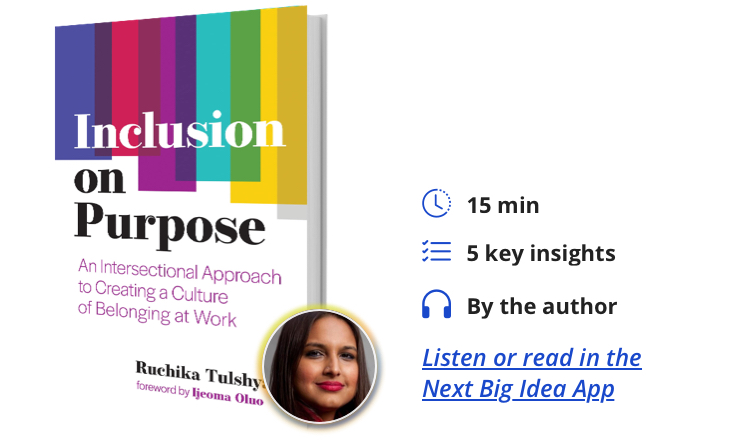Ruchika Tulshyan is the founder of Candour, an inclusion strategy consultation firm. She has also been a business journalist, covering diversity and leadership for Forbes.
Below, Ruchika shares 5 key insights from her new book, Inclusion on Purpose: An Intersectional Approach to Creating a Culture of Belonging at Work. Listen to the audio version—read by Ruchika herself—in the Next Big Idea App.

1. Inclusion takes intention—it doesn’t just happen naturally.
In 2015, I read a statistic that explained all the confusion I’d been feeling as an immigrant woman of color in America. Public Religion Research Institute found that three-quarters of white people in America don’t have a friend of color. For many Americans, the first time they meaningfully interact with someone from a different racial background is in the workplace. This made sense of why I had spent the majority of my corporate career feeling like an outsider in white-run organizations. Many people I worked with didn’t know what to make of me, with a name like Ruchika and my unfamiliar accent.
I’ve since learned that inclusion takes intention and regular practice. It doesn’t happen by chance. We’re hardwired to be drawn toward people like us, so we need to constantly disrupt our natural approach. We need to develop an acute awareness of who is represented, who’s getting hired, promoted, or thought of as leaders—and who is not.
It is impossible to correct what you can’t identify. To make meaningful progress, we must specifically seek what exclusion looks like, and the experiences of women of color are key to this inquiry. Then, it’s up to us to take the right steps to fix these issues, from advancing women of color to taking personal actions to be more inclusive.
2. Women of color must be center in all inclusion efforts.
In 1989, the incredible Professor Kimberle Crenshaw coined the term “intersectionality” to describe how the exclusion Black women faced in the workplace was not only due to gender bias, but was compounded by racism. All the women of color I interviewed shared how they face distinctly more negative experiences compared with white colleagues—even white women.
Shefali Kulkarni, a South Asian journalist, talked about facing harrowing exclusion while doing her job. None of her white colleagues were aware of the severity of her situation. Many women of color share the acute pain of being overlooked and underestimated, of being invisible and hyper-visible at the same time.
“Public Religion Research Institute found that three-quarters of white people in America don’t have a friend of color.”
We need change urgently. Institutional changes, like corporate diversity programs, are only part of the puzzle. Strategies must be intersectional to be effective, meaning they must prioritize women of color because they carry the two largest and most visible marginalized identities in the workplace. Without an intersectional approach, changes are incomplete at best, or at worst, inadvertently create cultures where women of color are discriminated against, while white women ascend. Starting by centering on women of color who have other marginalized identities is our greatest possibility of including everyone in a complex, nuanced world.
Women of color are on track to become the largest majority of women in the U.S. by 2060. Non-white women are already a majority in a global context. Without centering our voices, expertise, and leadership on corporate diversity, we can’t make meaningful progress toward a more inclusive and innovative workplace and society.
3. Focus on culture add, not culture fit.
Too many workplaces are focused on hiring for culture fit. This framing is exclusionary and biased, especially when it comes to hiring for leadership roles. If your organization is made up of white men, then you’re consciously or unconsciously going to pattern match for a “culture fit.” Tiffany Tate, a Black woman who is a Talent Development Expert, said she was rejected from a job she was overqualified for because she wasn’t a “culture fit” in the all-white organization.
Instead, look for culture add. Be intentional and honest about the perspectives and backgrounds that are missing. Name them. Spell it out. Having a clear understanding of who is missing helps leaders articulate to recruiters that they require a racially and gender-diverse slate of candidates. When interviewing people, they seek culture add, not culture fit.
Think back to the last time you talked about whether someone is a culture fit. What was it that made them a fit? Or did not make them a culture fit? The more trouble you have articulating why someone was or was not a culture fit, the more likely your judgment is biased.
“Having a clear understanding of who is missing helps leaders articulate to recruiters that they require a racially and gender-diverse slate of candidates.”
Instead, seek to hire people you don’t already have represented, by race, gender, educational background, experience, country of origin, languages spoken, and other identities. Normalize looking for culture add.
4. Build empathy through reading fiction.
I was disheartened by research from Dr. Jamil Zaki at Stanford University who found that there’s an inverse relationship between privilege and empathy. That means the more privilege you have, it’s generally harder to empathize with the experiences of others. So, leaders must develop empathy by constantly self-educating and building awareness of what different people are facing.
The Greater Good Science Center at Berkeley published phenomenal research on cultivating empathy. One of their research-backed recommendations surprised me: read fiction. Stories change us, and powerful stories often stay in our minds longer than data. Seek out stories from different cultures–written by authors from those backgrounds.
When it comes to building your empathy muscle through fiction, there is no shortage of prize-winning literature, film, or theater that can help. I was an avid reader as a child and often got lost in bookstores or libraries, much to my mother’s chagrin. But growing up in Singapore (a country with less than four million people when I lived there) I felt like I wasn’t exposed to the vastness of the world. Fiction became a necessary lifeline, and I could find myself empathizing with people wholly different from me.
Professionals sometimes over-index business books as a way to become a better leader. Often, the empathy we require lies within the experiences of fictional characters. We feel less defensive when a story is fictionalized, and we can experience a greater depth of understanding about a situation through details, context, and descriptions that can be lacking in nonfiction.
“The more privilege you have, it’s generally harder to empathize with the experiences of others.”
Recently, I’ve read three works of fiction that greatly influenced me: Homegoing by Yaa Gyasi, Convenience Store Woman by Sayaka Murata, and Mexican Gothic by Silvia Moreno-Garcia.
5. Cultivate cultural humility, not cultural competency.
Cultural competency is outdated. What we need is the cultivation of cultural humility. The difference is that cultural competency means learning about other cultures while retaining the idea that your culture is dominant. This approach assumes that the non-dominant (non-white) culture’s way of doing things is often exasperating or exotic—a quirk to accommodate, not something to respect or learn from. Cultivating cultural humility means recognizing that you do not know everything about another’s culture, and that there may be a lot to learn from it. Cultural humility is particularly useful for leaders working with women of color.
One small, but powerful, way to cultivate cultural humility is prioritizing the correct pronunciation of a colleague’s name. Cultural humility reminds us that all names are meaningful to their owner, so stumbling through an unfamiliar name for your own ease or comfort is unacceptable. Or, for instance, when doing business in an Islamic country, cultural competency would lead us to assume that no women shake hands with men. Cultural humility would guide us to observe specific practices in different countries, work cultures, and local environments, before adapting our behavior to the situation. Be wary of cultural bias: consider that countries around the world have had women heads of state, while the U.S. has not yet had a female president.
Cultural competency is broad and fixed, while cultural humility allows for nuance and flexibility. It prompts us to observe visual cues, not just verbal ones.
To listen to the audio version read by author Ruchika Tulshyan, download the Next Big Idea App today:





























